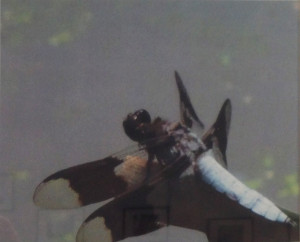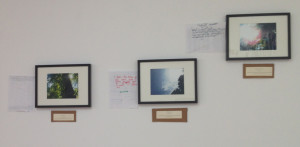By Elisabeth Zafiris, Manager of Public Programs
 When you think about sending your child to a nature-based summer camp, you probably picture them frolicking among trees, worms, and birds, but do you see photography as a way to build a relationship with the natural world?
When you think about sending your child to a nature-based summer camp, you probably picture them frolicking among trees, worms, and birds, but do you see photography as a way to build a relationship with the natural world?
At the Schuylkill Center, we do. Last week we offered a nature photography camp for our eight- and nine-year-olds, culminating in their very own gallery show.
Engaging with nature through art offers a unique way to connect with the natural world, using all five senses. It’s a direct, yet play-based, experience that encourages critical thinking and reflection on one’s own relationship to the environment.
[pullquote]
From Christina Catanese, Director of Environmental Art:
In environmental education, art making can be a powerful way to explore, inquire, and experience our environment, helping to develop not only environmental literacy but deeper, more emotional connections with nature.
[/pullquote]
For our campers, the experience of being in nature becomes relevant and personal through photography: that photograph of a flower, or bug, or tree is seen through their eyes, and they create a personal connection to what they observe. It’s no longer a random object that kids pass on the trail. They are now intimately connected to that object, turning it from something removed to something personal in their individual experience.
During middle childhood, kids are building their feelings of competency. Creating things, and getting recognition for the work they create, allows them to build confidence within themselves. Going through the creative process of photography allows them to build their feelings of competency. It allows them to get first-hand experience with a multi-step process that culminates in a finished product that is put on display for recognition by their peers and community.
The creative process itself also builds skills that are important – creativity, critical thinking, communication, and collaboration. Being able to look at the world with a creative eye challenges perceptions of the natural world; it allows one to focus observation skills and build close looking skills.
 For the campers in the nature photography camp, going through the editing process helped kids to think critically – why pick this photo, what are we trying to communicate to the observer, what is the best way to go about that? Creating the exhibition showed them that there is an ultimate goal for the work that they created, honoring and respecting their creativity and letting them communicate to a larger audience about their photographs and why they created took them. The gallery show at the end of the photography camp was an opportunity for these campers to work together on a unified project that gave space and relevance to each individual’s work.
For the campers in the nature photography camp, going through the editing process helped kids to think critically – why pick this photo, what are we trying to communicate to the observer, what is the best way to go about that? Creating the exhibition showed them that there is an ultimate goal for the work that they created, honoring and respecting their creativity and letting them communicate to a larger audience about their photographs and why they created took them. The gallery show at the end of the photography camp was an opportunity for these campers to work together on a unified project that gave space and relevance to each individual’s work.
And, we all had a lot of fun taking photos, exploring the Schuylkill Center, and learning to see nature through art.
